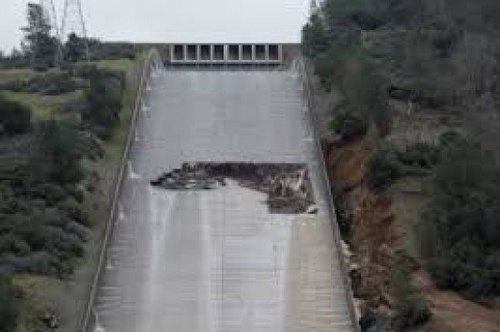The good news is the drought in Northern California is over, which is also the bad news.
Oroville in the Gold Rush country of the lower Sierra Nevada northeast of Sacramento is the tallest dam in America and its reservoir is the second biggest of the giant California State Water Project.
Here’s an old clip of what the Oroville Dam concrete spillway is supposed to look like, with water falling in an orderly fashion down the 770 foot elevation loss, only splashing up at the very bottom before falling into the Feather River:
And here’s what it looks like after the latest rainstorm as the bottom half of the spillway has more or less exploded, with huge chunks of concrete flying through the air, with the water carving a new canyon down to bedrock.
The engineers had to reduce the flow over the spillway to keep the top half from eroding away itself and undermining the integrity of the reservoir. But this inability to shed water from the reservoir faster than it flowed in from the recent rainstorm meant that the reservoir overflowed for the first time in its 48 year history.
Starting Saturday morning, water started spilling over the “emergency spillway,” which is actually just a 1,700 foot long lip of the lake that empties out onto a mountainside, kind of like the edge of your bathtub. The purpose of the Emergency Spillway is to drain the lake before it overflows the earthen dam itself, which could erode the dam on it’s less hardened down river side, which could conceivably lead to various other bad things, ultimately resulting in, more or less, no more Sacramento.
So far, the Emergency Spillway seems to be doing its job, although you’ll have new video Sunday morning to check whether this last-ditch system is working as planned hoped. But, best case scenario, the repair job on the Primary Spillway will likely cost nine figures.
This reminds me of SlateStarCodex’s giant current post on Cost Disease: why do so many different things such as public works projects, health care, and education keep getting more expensive?
I don’t know if there are any general lessons to be learned from Oroville.
But the body language of the public works engineers suggests some guilt and fear on their part. California was pretty broke a half decade ago, but the state could have afforded to fix the spillway recently if flaws in it had been discovered, but the staffers didn’t seem to inspect it terribly closely.
They don’t look like California’s A Team.
I wonder if the quality of public works engineers has declined as we’ve moved from the construction to the maintenance era. Fifty to 100 years ago, building dams was a highly prestigious profession. Waterworks engineer William Mulholland was perhaps the leading citizen of California and his rise and fall inspired a famous movie,
But few dams have been built in this century and mostly we just want the ones that we already have not to collapse. That’s not particularly attractive to top people looking for a career.














